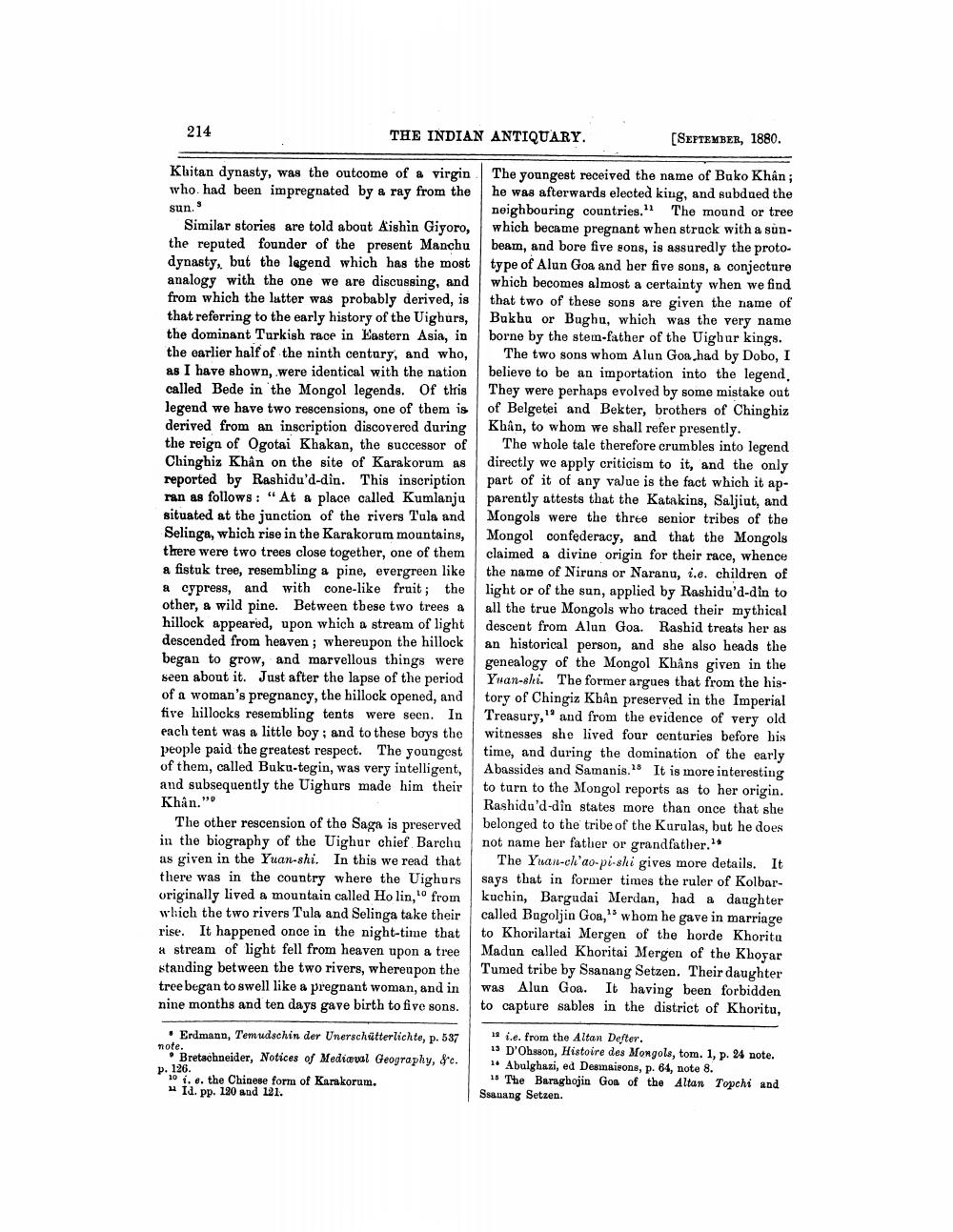________________
214
THE INDIAN ANTIQUARY.
(SEPTEMBER, 1880.
Khitan dynasty, was the outcome of a virgin who had been impregnated by & ray from the
sun.'
Similar stories are told about Aishin Giyoro, the reputed founder of the present Manchu dynasty, but the legend which has the most analogy with the one we are discussing, and from which the latter was probably derived, is that referring to the early history of the Uighurs, the dominant Turkish race in Eastern Asia, in the earlier half of the ninth century, and who, as I have shown, were identical with the nation called Bede in the Mongol legends. Of this legend we have two rescensions, one of them is derived from an inscription discovered during the reign of Ogotai Khakan, the successor of Chinghiz Khân on the site of Karakorum as reported by Rashidu'd-din. This inscription ran as follows: "At a place called Kumlanju situated at the junction of the rivers Tula and Selinga, which rise in the Karakorum mountains, there were two trees close together, one of them a fistuk tree, resembling a pine, evergreen like a cypress, and with cone-like fruit; the other, a wild pine. Between these two trees a hillock appeared, upon which a stream of light descended from heaven; whereupon the hillock began to grow, and marvellous things were seen about it. Just after the lapse of the period of a woman's pregnancy, the hillock opened, and tive hillocks resembling tents were seen. In each tent was a little boy, and to these boys the people paid the greatest respect. The youngest of them, called Buku-tegin, was very intelligent, and subsequently the Uighurs made him their Khân."
The other rescension of the Saga is preserved in the biography of the Uighur chief Barchu as given in the Yuan-shi. In this we read that there was in the country where the Uighur's originally lived a mountain called Ho lin, from which the two rivers Tula and Selinga take their rise. It happened once in the night-time that a stream of light fell from heaven upon a tree standing between the two rivers, whereupon the tree began to swell like a pregnant woman, and in nine months and ten days gave birth to five sons.
The youngest received the name of Buko Khân; he was afterwards elected king, and subdued the neighbouring countries. The mound or tree which became pregnant when struck with a sunbeam, and bore five sons, is assuredly the proto. type of Alun Goa and her five sons, a conjecture which becomes almost a certainty when we find that two of these sons are given the name of Bukbu or Bughu, which was the very name borne by the stem-father of the Uighur kings.
The two sons whom Alun Goa had by Dobo, I believe to be an importation into the legend, They were perhaps evolved by some mistake out of Belgetei and Bekter, brothers of Chinghiz Khân, to whom we shall refer presently.
The whole tale therefore crumbles into legend directly we apply criticism to it, and the only part of it of any value is the fact which it apparently attests that the Katakins, Saljiut, and Mongols were the three senior tribes of the Mongol confederacy, and that the Mongols claimed a divine origin for their race, whence the name of Nirons or Naranu, i.e. children of light or of the sun, applied by Rashidu'd-din to all the true Mongols who traced their mythical descent from Alun Goa. Rashid treats her as an historical person, and she also heads the genealogy of the Mongol Khans given in the Yuan-shi. The former argues that from the history of Chingiz Khân preserved in the Imperial Treasury," and from the evidence of very old witnesses she lived four centuries before his time, and during the domination of the early Abassides and Samanis. It is more interesting to turn to the Mongol reports as to her origin. Rashida'd-din states more than once that she belonged to the tribe of the Kurulas, but he does not name her father or grandfather."
The Yuan-ch'ao-pi-shi gives more details. It says that in former times the ruler of Kolbarkuchin, Bargudai Merdan, had a daughter called Bagoljin Goa," whom he gave in marriage to Khorilartai Mergen of the horde Khorita Madun called Khoritai Mergen of the Khoyar Tumed tribe by Ssanang Setzen. Their daughter was Alun Goa. It having been forbidden to capture sables in the district of Khoritu,
Erdmann, Temudschin der Unerschütterlichte, p. 537 * Bretschneider, Notices of Mediæual Geography, &c. p. 126. 10 1. e. the Chinese form of Karakorum. u Id. pp. 120 and 121.
Hi.e. from the Altan Defter. 13 D'Obsson, Histoire des Mongols, tom. 1, p. 24 note. 1. Abulghazi, ed Desmaisons, p. 64, note 8.
15 The Baraghojin Goa of the Altan Topchi and Ssenang Setzen.




